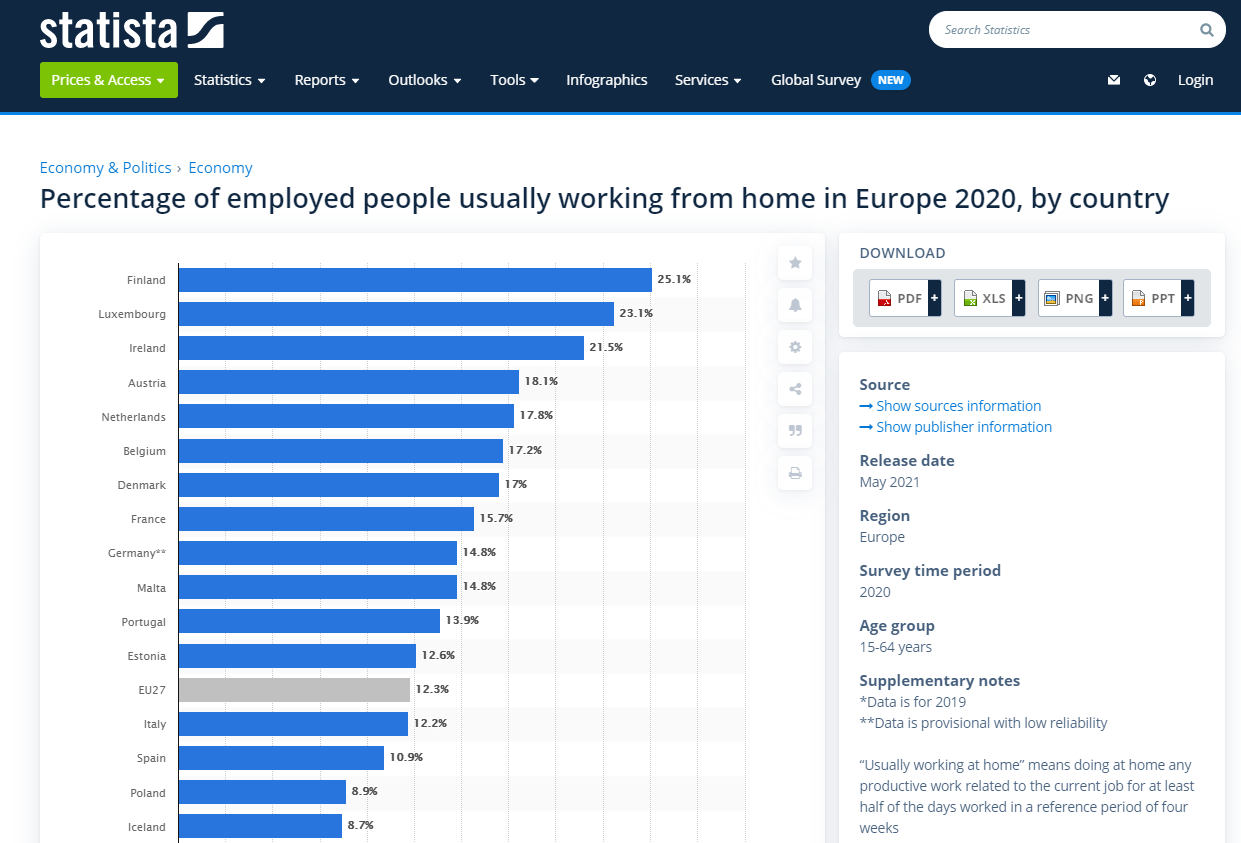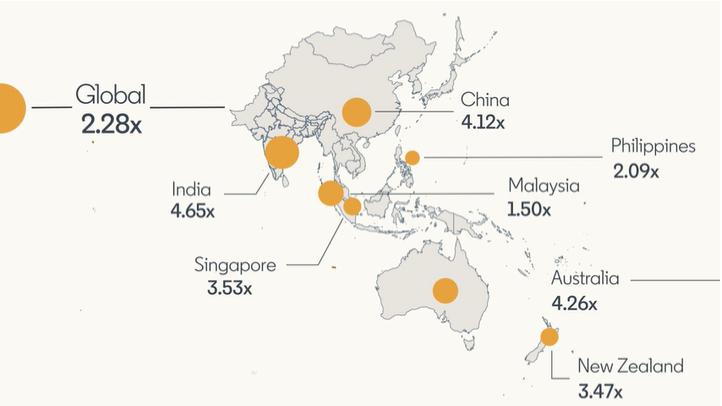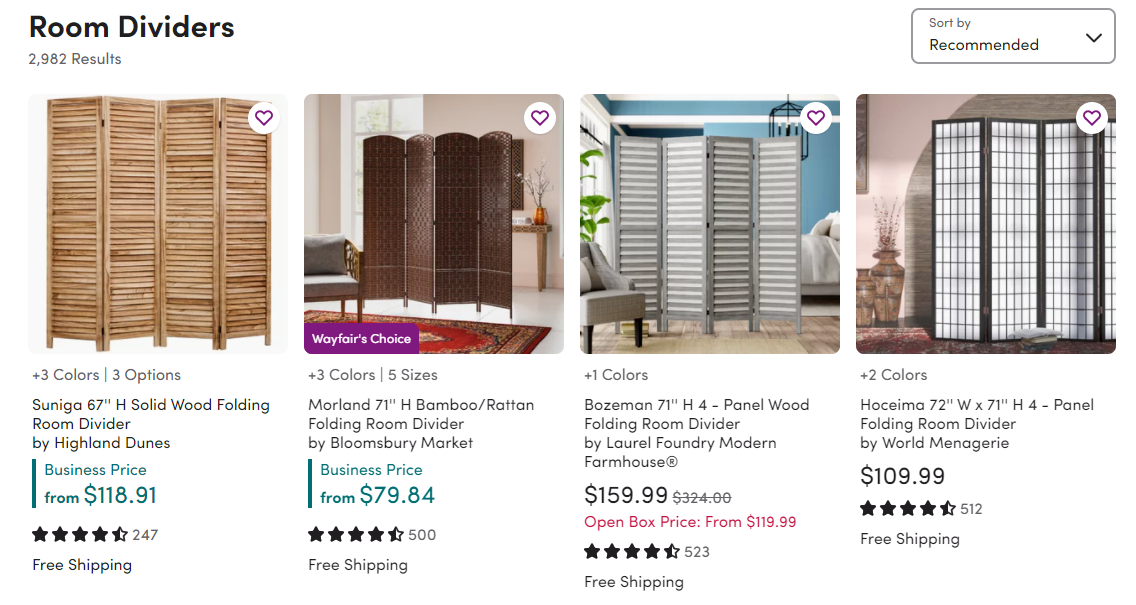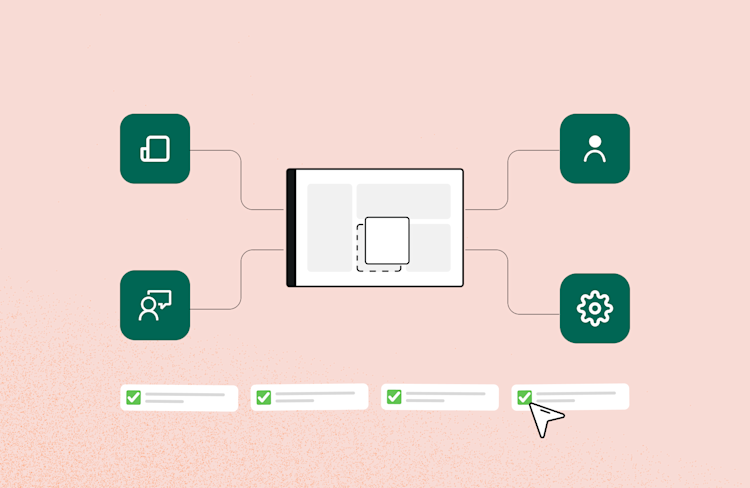Work From Home: Everything You Need to Be Successful
Whether you want to work from home, already do WFH, or are in charge of managing remote workers, this guide offers insights and advice.

Working from home got so popular, it has its own acronym: WFH.
The concept is nothing new. Afterall, “telecommuting” was a thing in the 90s.
But the demand for remote work jobs has skyrocketed. In this post-pandemic landscape, 96% of non-frontline workers want some form of remote working flexibility.
There’s a lot of competition for remote jobs, which pay higher than the average US salary and even pay more than their exact in-office counterparts.
Whether you want to work from home, already do work from home, or manage a team of employees who are all working from home, this guide is for you.
What’s in this guide:
The work-from-home revolution
How to be productive and healthy when you WFH
How to manage employees who work from home
How to find work-from-home jobs
How to create a work-from-home business
The work-from-home revolution
Fifth Harmony was ahead of the trend. Their 2016 Work from Home song is still such a bop. YouTube commenters are calling it the “pandemic soundtrack.”
While the COVID-19 pandemic certainly propelled working from home to new levels, the trend was already well underway.
The percent of at-home workers around the world
Because of their IT infrastructure and hardware availability, the countries with the largest economies have more remote work opportunities when it comes to traditional employment. Gig and freelance work on the other hand, is popular in both developed and developing countries.
In the United States, 25% of adults, or 39 million Americans, are expected to work from home in 2021.
When we look at the EU as a whole, the percentage of people who work from home is much lower (12%), but some individual European countries do have levels of remote work that match the US, such as Finland (25%) and Luxembourg (23%).

Source: Statista
In the UK, 26% of the workforce is predicted to work from home at least three days a week this year.
And in the APAC region, India experienced the most growth in remote jobs, with 4.65 times the number of remote jobs listed on LinkedIn compared to the previous year.
Here’s what the growth in job listings for remote positions looks like throughout APAC:

Source: LinkedIn Talent Solutions
Indian workers were also more likely to state that working remotely increased their productivity when compared to workers in Australia, New Zealand, South Korea, Malaysia, Thailand and other APAC countries.
Work-from-home statistics
Are remote workers still productive? Does this trend really help the environment? Here are some interesting statistics about WFH life.
Employee desire and engagement:
65% of non-frontline workers want to be full time remote employees and 31% want a hybrid option, which totals 96% who want some form of remote work. (Flexjobs)
Businesses lose $600 billion a year to workplace distractions. (Global Workplace Analytics)
Remote workers are 35% more productive than their in-office counterparts. (Global Workplace Analytics)
Remote workers are more likely to report that they are satisfied with their jobs than office-based workers. (SurveyMonkey)
95% of remote workers say that their productivity has been the same or higher since working from home. (Flexjobs)
Pay and savings:
While 74% of remote workers earn less than $100,000 per year, 92% of on-site workers earn less than $100,000. (Owl Labs)
26% of remote workers earn more than $100,000 per year. But only 8% of on-site workers earn more than $100,000. (Owl Labs)
Remote workers make 8.3% more than non-remote workers doing the same job and with the same qualifications. (PayScale)
At-home workers save approximately $4,000 per year by avoiding commuting, lunches out of the home, and clothing purchases. (Flexjobs)
Environmental impact:
28% of US greenhouse gas emissions are from the transportation sector. (EPA)
39 million Americans are predicted to work remotely in 2021, resulting in 70 to 140 billion fewer commuting miles. (Flexjobs)
Office buildings are more energy efficient than homes, meaning increased at-home heat and cooling could negatively impact the environment. (BBC)
Factors driving the growth of working from home
There are a lot of contributing factors when it comes to the rise of remote work. On the technological side, there's expanded WiFi availability, faster internet speeds, and better computer processing capabilities in home devices.
But what’s most interesting is the demand for flexibility from workers.
WeWork CEO Sandeep Mathrani found himself in hot water for stating that the “least engaged” employees are the ones who want to work from home.
In reality, there can be lots of reasons why a skilled and engaged worker would want to stay home:
Reducing a commute to spend more time with family
Increased flexibility with childrens’ after school care
Difficulty focusing in the office due to constant distractions
Anxiety in the workplace or introversion that causes workplace exhaustion
Ability to work out or get some light housekeeping done during lunch breaks
What working from home looks like post-pandemic
While some people want to go back to working in an office, many do not. Only 2% of pandemic remote workers said they want to return to the office, and 58% said they would look for a new job if they were forced to return in person.

That’s a lot of pressure on employers. With all of that pressure, it’s certain that many employers will allow full or partial remote work in order to retain employees.
No wonder a recent study found that 80% of employers will allow partial WFH after the COVID-19 pandemic. In another survey, 78% of CEOs agree that remote collaboration is here to stay.
How to be productive and healthy when you WFH
Do you work from home? These tips will help you stay both productive and healthy.
How to create a home office setup that will boost your productivity
Most at-home workers cannot afford a home office. In many markets, real estate prices are rising and it isn’t easy to just buy a home with an extra room or add one on.
There are startups trying to fix that problem.
You could buy a Focus Room for $14,995.

Or a Studio Shed for $11,455.

If these things are out of your price range or your company’s budget, that’s okay.
You could opt for a desk with a built-in cubicle:

If you’d rather stand up while you work, you could choose an Autonomous desk (just hit a button to raise and lower it so you can both sit and stand).

To get that much-needed privacy, try adding a room divider to separate your office space from your living room or bedroom.

Separating your office space in some way will help you reduce distractions and make it easier glide into focus mode when it’s time to work.
And of course, you’ll need a chair. You could order one online, but you might be better off heading to the nearest office supply store and testing out a few to find your perfect match.
You might also want headphones (to play ambient music) or noise-canceling headphones if your family or roommates are home. And of course, you need a laptop or desktop computer. Computers last longer and work faster, so if you’ll be primarily working from home, it might be time to ditch that laptop.
A Blue Snowball microphone and a standing ring light will set you up for video call success.
The best software tools for working from home
When you work from home, some company processes will stay the same, and others will change. While you might use the same tool for expensing a purchase, you definitely can’t use the same tools for a meeting, which must now take place virtually.
Here are some of our favorite remote work tools:
Whereby - With Whereby, you can name your own meeting link to use again and again for convenient meeting invitations and impromptu chats. There’s no need for anyone to download software or make a new meeting room.
Slack - If you use email for every conversation, your inbox will be stuffed. Instead, chat with colleagues in channels and private messages to spare everyone’s inbox.
Donut - This cool app will randomly connect employees from the same company via coffee chats and direct Slack messages so people get to know each other even while working remotely.
Zapier - You can use Zapier to automate manual work actions and integrate data sources together. Last time we checked, it connects with over 3,000 apps.
Mailbird - An email client for Windows desktop. (Rumor has it a version for Mac is on the way). The app is chock full of features and integrations, but their interface is clean and simple, giving you a little inner peace while you work towards Inbox Zero.
Asana - One of the top project management tools, Asana is a powerful app for organizing work as a team into tasks and their associated to-dos.

Tips for taking care of your mental health while working from home
Four out of five remote workers find it hard to “shut off” in the evenings. 76% say that work-related stress affects their mental health, but 48% say that they lack emotional support from their employer to deal with this.
You matter. Talk to your manager or HR about what mental health services your company provides. If your organization has a lot of at-home workers, they might have a contract with a remote mental health service like Two Chairs or Inuka. They might also provide a subscription to Calm or Headspace to help you cope.
If you’re self employed, mental health services should be covered by your health insurance. Get help when you need it, no matter what.
Also, try these tips to boost your mental health:
Turn off notifications during your focus time so you can get things done without constant interruption
Turn off notifications after hours and don’t check your email unnecessarily to ensure you’re separating work from home even if they do live under one roof
Use tools and agreed-upon processes to increase communication and collaboration to reduce stress as a team
Take a mid-morning 15-minute break, a lunch break, and a mid-afternoon 15-minute break to re-energize
Stand or move around during calls or video trainings (physical activity has a big impact on mental health)
Tips for taking care of your physical health
A convertible stand up desk can be amazing for your physical health. Sitting too much every day increases your risks of heart disease, diabetes, stroke, high blood pressure, and high cholesterol.
If you can’t afford to buy a new desk, aim to stand at least 30 minutes a day. You could stand during non-video phone calls and when you’re watching video trainings or listening to a podcast. You could also stand while you eat lunch.
Add some five to 15 pound dumbbells in your office space and do squats, lunges, and bicep curls once a day. If you don’t have time for a walk around the block, walk up and down your street or driveway a couple of times.
Plan your meals ahead of time and take a regular lunch break. Prepare easy-to-heat-and-eat meals on Sundays whenever you can.
How to manage employees who work from home
Do you manage a remote team? Here’s how to improve onboarding, team health, and corporate culture.
How to onboard remote employees
A great onboarding program takes an initial time investment to set up, but is far worth it in the long run. You can use a platform like Trainual, Lessonly, or Notion to systematize and store your onboarding.
In your onboarding platform, include:
Company culture materials
Brand assets and voice guides
The names and locations of your various tools for communication, collaboration, digital asset management, etc.
Standard operating procedures and training materials for common processes
Team and individual KPIs, and how these are tracked and measured
The best apps and services for boosting the health and productivity of at-home workers
As a team leader, it’s up to you to provide the resources your team needs to not only get things done, but also be healthy and happy. While it might seem like boosting productivity is a selfish aim, it’s not. When your workers are productive, they can get things done faster, stress less, and spend more down time with their family and friends.
FocusMe - Likely the best productivity app available, FocusMe can be set to block any site you want. You can do a forced blocker that won’t allow you to scroll Twitter no matter what, or set up a password.
Clockwise - If you struggle to protect your calendar, Clockwise can help. It automatically blocks out focus time and it can measure the amount of meeting time, focus time, and fragmented time of your whole team.
Endel - This app plays music for deep work, chill, self care, studying and other use cases. It’s an easy way to get lyric-free music that won’t put you to sleep.
Calm - A popular meditation and sleep app, Calm has a business plan so companies can purchase it for their employees.
WaterMinder - Need a reminder to drink water? This app is your friend.
Reboot - Most knowledge workers plow through the day without taking breaks. While it seems like this would help productivity, it doesn’t. Everybody needs a reboot. This aptly named app will remind you to take a break.
Dailyburn - The Netflix of workout videos, Dailyburn’s exercises typically range from 10 to 40 minutes. You can search by your time allotment, favorite trainer, or workout style.
Two Chairs - This is a well-reviewed company for teletherapy, if you’re looking for such a service.
Inuka - Another great teletherapy option, Inuka focuses on proactive problem solving and stress management.
How to preserve corporate culture from home
While some CEOs worry about how remote work might erode company culture, others have fostered company culture without anyone ever setting foot in an office.
When working from home, it's easy to ignore team building and connection-making. Don’t. Make sure that someone in each team or department is in charge of hosting monthly activities. You can do food tastings (ship everything in advance), games, and informal meetups.
Most importantly, vet that someone fits your company culture when hiring. To do so, you need a well-defined culture to begin with. You might value impact over effort and humility, for example. The clearer your company culture is, the easier it will be to find people who match it well.
Investing in remote employees’ home offices
Employee turnover is expensive. The costs of hiring a new employee include position marketing and recruiting, training costs, and lost productivity and engagement from other team members.
So if paying for comfy home office furniture and computers with lightning fast operating speeds sounds expensive, think again.
Investing in your employees’ home office setup means you’re investing in your employees. One tech startup, Flatfile, spends up to $10,000 on each employee so they can create a “bespoke” home office. That comes with an interior designer to help make decisions. For one employee, a designer transformed part of their garage into a bonafide office.

CEO David Boskovic says in an interview with Inc.:
"Silicon Valley startups hand out gourmet lunches, free pet-grooming, and paid transportation like candy. We want working remotely to have truly exceptional benefits as well."
Don’t have the budget to spend on your team? Speak with other managers, directors, and executives about getting a flat rate budget approved for each new employee, and consider an annual maintenance budget too.
How to find work-from-home jobs
Want to work from home? It is pretty awesome. Here’s what you need to know about securing the perfect remote job.
Industries and roles best suited for working from home
Those who can work at home are those who don’t need to interact in person with clients, customers, or patients, and don’t need extensive hardware or equipment.
An Apple software engineer can easily work from home, but someone creating the next iPhone can’t. In fact, during the height of the coronavirus pandemic, tech companies sent their hardware-related employees back to work as soon as allowed, but kept everyone else home.
In general, great work-from-home roles include marketing, sales, finance, operations, and software development. You can work from home in the following industries: tech, insurance, media, entertainment, ecommerce, and more.
Even traditional industries have work-from-home jobs. For example, in the food industry, sales reps can work from home. And in the hospitality industry, marketers work from home.
And remember, almost every industry needs every type of worker, so don’t count yourself out before you try.
Top work-from-home jobs that pay above-average salaries
Remote jobs pay higher than on-site jobs. That’s because they tend to be knowledge, information, and strategy jobs. Also, companies that value remote work tend to pay slightly higher for the same role.
Here are some of the best work from home jobs:
Graphic designer
Copywriter
Software developer
Photographer
Realtor
Transcriber
Virtual executive assistant
Recruiter
Website and app tester
Where to find work-from-home jobs
Fortunately, in today’s remote working environment, it’s easy to find listings for remote jobs. Most sites will allow companies to select “remote” instead of a city name, making it quicker for you to find those listings.
The best sites for finding remote jobs include:
LinkedIn Jobs
Indeed
Flexjobs
Hubstaff
Remote.co
Crossover
Outsourcely
All of these sites have full-time remote work positions across multiple roles and industries. Side note: Whereby has plenty of completely remote positions available.
The skills you need to work from home
To successfully work from home, you need to have a marketable skill set that employers want. You could be great at project management, writing, designing, customer service, selling, interviewing customers, or taking care of HR needs.
If you don’t have such a skill set, consider taking an online test or working with a career coach to discover the best skill for you to develop. Then, look for a trusted certification you can take in order to get a job with no previous related work experience.
Can service-industry employees and frontline workers find ways to work from home?
Clearly, it’s easier to work from home if you’re doing computer work. However, some traditionally frontline jobs are turning remote. For example, there is remote learning, teledoc appointments, teletherapy appointments, and online customer service. If you really want to work from home and have a more traditional skill set, you can possibly move into a different department (management or marketing), or you can offer the same service from home.
How to create a work-from-home business
Building a business isn’t for the faint of heart. You need to be somewhat of a rebel, or have a very strong motivation to work from home. Here’s how to pull it off.
Categories of work-from-home businesses
While there are hundreds of different things you could do to earn a full time living from home, all of these things can fit into a few main categories.
Consulting and freelancing - You can offer professional services like bookkeeping or tax preparation. Or you can be a freelance content marketer. Consulting is similar to freelancing, except this term is typically used by someone with more experience, and who offers a holistic approach to strategy and management.
Home and construction services - You can run an at-home business and manage a team of house cleaners or landscapers.
Affiliate marketing - As an affiliate marketer, you create content (blog posts, YouTube videos, tweets, etc.) and link to other people’s products and services. You get a commission for this.
Content creator - If your YouTube channel or blog takes off well enough, you can make a living from the ad revenue alone.
Ecommerce - Sell products on Amazon and create a storefront using software like Shopify or BigCommerce.
Infopreneurship - As an infopreneur, you can make money selling a course about pretty much anything. Popular course niches include marketing, arts and crafts, and off-the-grid living.
A course on van life? Consider it proof that your creativity is the limit.

The best work-from-home tools
To work from home as a business owner, you need the right toolkit. For at-home meetings, try Whereby, a voice and video conferencing app that doesn’t require participants to download software. For project management, Asana is a top choice. And for creating and managing your website, you can’t go wrong with Contentful. You’ll also need a bookkeeping app like QuickBooks to keep track of revenue and expenses.
How to get more clients for your services
If you’re selling professional services, the quickest ways to get clients are cold email pitching and LinkedIn marketing. Craft an informal pitch and reach out to your ideal clients. Set up your LinkedIn profile with a sales-letter style description, connect with your ideal clients, and post tips and tricks regularly.
If you’re selling local services like childcare or landscape architecture, your best bet will be SEO. Optimize your website and your business listings for relevant keywords. Then, request reviews from your clients regularly. Businesses with the most positive reviews show up higher in Google Map search results.
How to get more customers for your products
Are you daring enough to sell products online? Affiliate marketing might be your quickest path to revenue. If you partner with micro-influencers (people without massive audiences), you can entice them to post about your products in exchange for free goods, no payment necessary.
Other great strategies for product-based businesses include growing your social media audiences with useful or entertaining content, creating SEO-optimized product listings and blog posts, and running ads on Facebook, Instagram, and TikTok.
How to make the leap to a full time small business income
It’s definitely worth noting that the fastest path to a full time income lies in selling freelancing or consulting services. It takes a lot of effort, luck, and good timing to win with an ecommerce or affiliate marketing business.
So, start by offering a steady service, such as virtual assisting, before graduating to tougher (but more scalable) business models.
Working from home is here to stay. And with young generations seeing adults enjoy the flexibility of working from home, the demand is sure to grow.
Ready to work from home smarter?





